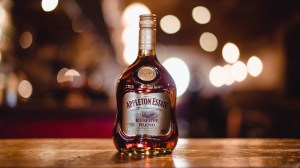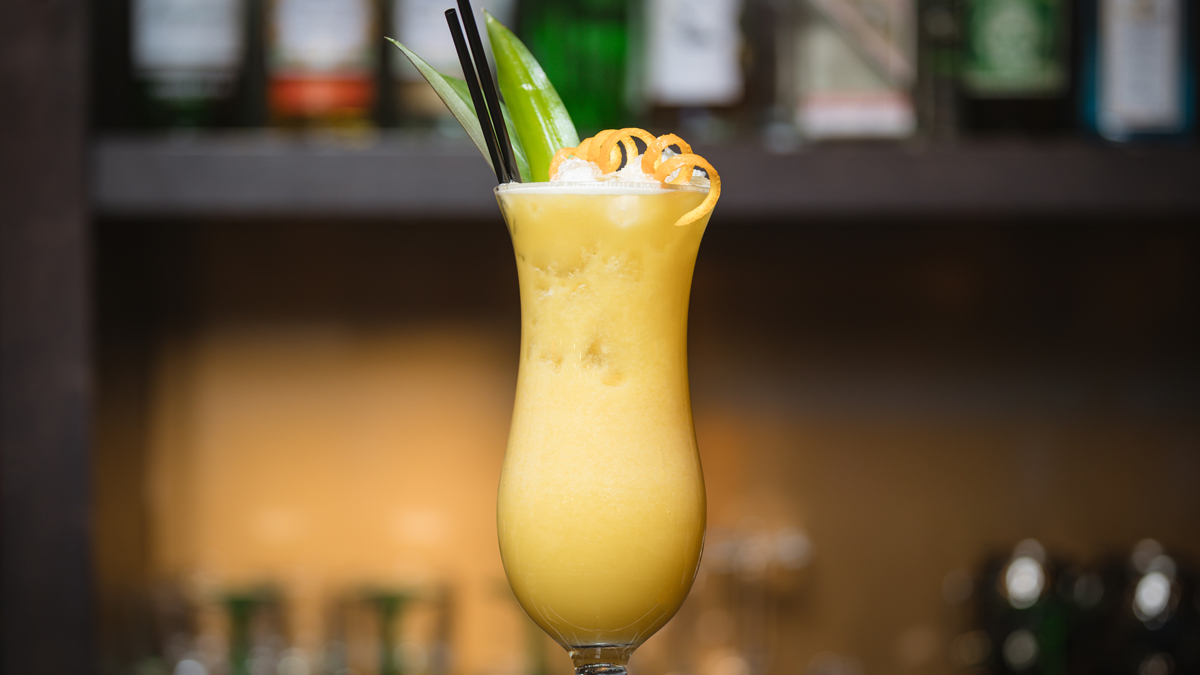The strangest thing about the Brancolada is probably how weird it isn’t.
A Brancolada is a with half the rum replaced by Brancamenta, a version of the amaro Fernet Branca accented with extra peppermint oil. If you’re familiar with Fernet Branca at all, you could, at first glance, be forgiven for thinking this is some kind of prank. Sorry—Fernet Branca? The sharply bitter, garishly intense Italian liqueur, among the most polarizing bottles behind any given bar and the liquid equivalent of being beaten to the ground with a sack of herbs? That Fernet Branca?
Yes, that Fernet Branca. The Brancolada was invented by Jeremy Oertel in 2012, at Donna in New York. One of his previous bars had a machine on the bartop that dispensed chilled Brancamenta shots, and one of the servers would bring ice cream sandwiches to work, wherein the staff would drizzle these creamy sweet treats with the minty, bitter liqueur.
It was the seed of an idea. Oertel already had a taste for embittering the tiki classics (he invented the Campari-laced Bitter Mai Tai at that previous bar, called Dram) and so spliced an ounce of Brancamenta into the Piña Colada and subbed orange for lime juice (a vital choice, more on this below). He called it the Brancolada and put it on the opening menu of Donna.
As a bartender it’s hard to know how the public will respond to such a thing, but the Brancolada was a huge hit. Early reviews rave about it. It was a favorite of both bartenders (read: people who already loved Fernet) and normies (read: people who don’t) and it immediately became a signature of the bar and a mainstay on the menu. Donna in its original Brooklyn location closed in the pandemic but reopened in the West Village in 2022, and there’s the Brancolada, still on the menu, and still a crowd favorite.
This is because the Brancolada is, incredibly and as mentioned, not weird. We can count on one finger the amount of times you can substitute a light mild rum for a Fernet Branca product and have the resulting cocktail be nearly unmoved, and it’s this—the coconut and pineapple absorb the aggression of the liqueur with ease.
What it does do is give the drink a different valence. If the classic Piña Colada is the ultimate summer drink, it’s also the cocktail equivalent of wearing white—it’s a sunny treat, and it feels semi-inappropriate to have one before Memorial Day. The Brancolada, on the other hand, is the same pitch but with the spin reversed; it’s pulling darker, more herbaceous, still juicy and creamy and tropical but deeper and more grounded, with a chocolate-mint presence pulsing throughout the whole experience. Put another way—if the Piña Colada is the naive exuberance of first love, the Brancolada is like meeting your soulmate in your second marriage: It’s neither doe-eyed nor giddy, but it’s true love all the same.
Brancolada
- 1 oz. aged
- 1 oz. Fernet Brancamenta
- 1.5 oz. pineapple juice
- 1 oz. coconut syrup or Coco Lopez
- 0.25 oz. orange juice
Put all ingredients together in a cocktail shaker, add crushed ice, and “whip shake” briefly to incorporate the ingredients. Pour into a hurricane glass and fill with more crushed ice. Garnish with a mint sprig and/or an orange half-moon.
NOTES ON INGREDIENTS

Photo: courtesy Appleton Estate
Brancamenta: I tried this with the regular Fernet Branca so you wouldn’t have to. Honestly, it’s not horrible (I love Fernet), but that this works at all is some kind of magic trick, so don’t mess with this variable. Use Brancamenta or just make a standard Piña Colada (or a , which is a similar idea but a different vibe entirely)..
Aged Rum: Oertel calls for Appleton Estates, a Jamaican rum with some weight but not much of that signature Jamaican funkiness, and it works great. As did most of the rums I tried this with. The Brancolada is pretty forgiving across styles of rum, and I think it’s even less particular than the classic Piña Colada is. That said, stay away from anything too funky like Smith & Cross or Dr. Bird and make sure it’s aged, and you’ll be fine.
Coconut Syrup: As far as I’ve been able to discern, the best coconut syrup for is to start with Coco Lopez and mix it 3:1 with unsweetened coconut cream. Now, I realize as a product, Coco Lopez leaves a lot to be desired—there are about six too many ingredients, the label looks like the can has been sitting on the shelf since the late ‘80s, and when you open it, that the liquids and solids have long ago separated and you essentially need a blender to turn it back into something pourable doesn’t help, to say nothing of the fact that it is too thick to pour at fridge temperature. It’s extremely annoying. The problem is that it tastes so damn good and is, to date, the best coconut syrup in cocktails I’ve yet tried, so it’s hard to know what to say here. Feel free to keep shopping for alternatives, as I am. I just have yet to find something I like as much.
Orange Juice: What is the orange juice doing here? When I first read the recipe it seemed mysterious, but when you start to fiddle with it, it becomes clear: You need some acidity, but like the , even a quarter ounce of lime juice is way too much. Even a little excess acidity shoves this cocktail off its pedestal of greatness. I imagine Oertel tried it first with lime (too acidic) then tried it without citrus (not acidic enough) and then tried orange and loved it. Orange juice is such a weak ingredient you’d think a quarter ounce it would be a waste of time, but you miss it when it’s not there.
Authors
-

Jason O’Bryan
Jason O’Bryan has set up a professional life at the intersection of writing and cocktails. He’s been managing cocktail bars for the last twelve years, first in Boston and now in San Diego, where he’s…
Credit: robbreport.com











